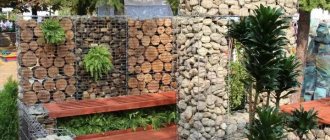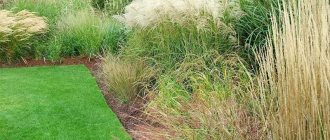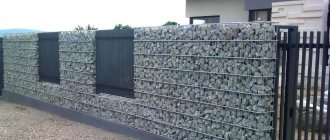Gabions are supporting and decorative structures made of durable metal mesh filled with stones. Gabions have evolved from military fortifications into landscaping structures. Since the 16th century, such products have been used to build defensive fortifications for guns and trenches. In the 19th century, builders became interested in gabions - they used them to strengthen steep slopes and areas with unstable soil, erect supports for bridges and dams, and strengthen river beds. Modern landscape designers use gabions to build fences, terraces and create small architectural forms.
Interesting! Properly made gabions are as strong as a concrete slab! The main thing is to choose the right materials.
A little history
A cage or basket filled with any stones protected batteries and troop positions from bullets and shrapnel in many wars.
The invention of this prefabricated means of fortification is attributed to Napoleon, but it was known long before the emperor began his wars.
The name itself - gabion - is a transliteration of the Italian word - gabbione, which means - a large cage. (gabbia - cell).
Gabions stepped from the battlefields into peaceful life. At first, they were used to strengthen slopes against landslides and banks against erosion. Then landscape designers paid attention to these light and durable structures.
Today gabions are at the peak of popularity in landscape design.
It is based on a successful combination of many shape options, aesthetic properties and practical benefits - you can create many structures for different purposes, mix the unevenness of the site, and provide sound insulation.
Another plus is the wide selection of materials for filling the gabion.
Basic types of gabion products
There are, in fact, three main varieties: gabions are box-shaped, cylindrical and mattress-mattress (in other words, Reno mattresses).
The first, in the form of parallelepipeds, are to strengthen steep banks, slopes, walls, and make high fences from them.
The latter are presented in the form of cylindrical baskets, more suitable for creating decorative accessories - columns, columns and the like.
Third, they line flat areas and fix the bottoms of reservoirs.
These are the basic types of gabions, but of course there are more variations: cubic, spherical, conical...
Gabions can be of almost any shape, with any filling, which makes these structures especially attractive in the eyes of landscape design specialists.
Choosing a filler
Almost any natural or artificial stone can be used for gabions. Preferably hardwood, frost-resistant, durable.
Small boulders, cobblestones, large pebbles, and crushed stone look good in gabions. The density of gabion stone reaches 1.5t/m3.
This parameter should be taken into account at the design stage. Glass, brick, broken tiles and paving stones are also used.
Artificial colored transparent crushed stone is popular as a filler. Illuminated by LEDs, it will sparkle in the area with lights of all colors of the spectrum, like a high-tech lamp.
It’s not for nothing that photos of gabions on a site become a source of pride for their owners.
Do-it-yourself gabions: step-by-step construction instructions and its features
To make your work easier, you can purchase ready-made designs. Modern stores offer a wide range of products for forming gabions. But finished frame parts do not always correspond to the required dimensions. In some cases, it is easier to create a gabion yourself. The first stage of construction involves designing the future composition and calculating the required amount of materials. If you want to make the structure yourself, you can use photos of gabions for inspiration and create a design for your own unique project.
Design is carried out according to the following scheme:
- Taking measurements from the territory.
- Marking.
- Transferring the markings to paper (structure layout plan).
- Drawing up drawings for each object.
- Selection of fillers and materials.
- Calculation of the required amount of materials.
Step-by-step diagram of assembling a gabion and filling it with stones.
Helpful advice! Materials should be purchased in reserve. The calculation result needs to be increased by about 10-15%.
To achieve high strength, it is recommended to purchase mesh with double torsion. It has a flexible structure, is easy to store and transport, durable and resistant to the negative effects of external factors.
Constructions for landscaping
The range of use of gabions in landscape design in suburban areas is unusually wide. Their design allows you to create many landscape design objects.
Gabions of rectangular shapes are used when constructing original fences, solid or combined, borders for beds and flower beds, creating arches, fountains and waterfalls.
And also - as an element of garden furniture, of course, in combination with wood, when decorated in the same style of gazebos or patios.
Round shapes - balls made of gabions, will also find a place on the site, like pedestals for garden sculptures or flowerpots, in rock gardens.
Application in landscape design
Having considered the types of gabions, we can say that the scope of their use is wide. They can:
- Serve as supporting structures
- Become a slope terracing material
- Used to strengthen the bottom and banks of reservoirs
- Frame flower beds, decorative compositions
More original ideas are also possible, which can be brought to life using filled mesh frames:
- Fences that can either limit the territory of the entire site or divide the space within the perimeter. In this case, zoning of the territory occurs, which complicates the design of the site. Gabions are especially compatible with green fences, but it is possible to build an independent fence from them.
For zoning, it is not necessary to use high fences; these can be low curbs.
- Outdoor hearths and fireplaces can also be made from gabions. However, in order for their operation to be safe, it is necessary to select a filler that is resistant to high temperatures. Not every stone is suitable for these purposes.
- Benches, dining tables and tea tables made of gabions, complemented by wooden or glass details, will be a useful decoration for the relaxation area. Such furniture is much more durable than usual and does not deteriorate at the base.
- Columns for gazebos or tents, which are the basis for the roof of a building.
- Decorative sculptures made in the form of animals and geometric shapes, compositions with abstract shapes.
- Original lamps if you place an LED strip inside.
The most suitable type of construction for most of the options listed is box-shaped.
Gabion fencing
A gabion fence is perhaps one of the most popular structures. It can be quite simple to install, and, at the same time, original in form.
At the same time, it not only separates the area, but also has good noise-absorbing properties. It can be given any configuration, any stones can be used to fill it.
The combination of gabion sections with hedges and other materials looks original.
What is gabion mesh filled with?
The first, “soldier’s” containers were filled with earth, grass and driftwood, with everything that came to hand.
The most popular, however, are gabions with stone “insides”. By the way, these have been made since ancient times not only in Europe, but also in Japan. Suitable fragments of granite, sandstone, dolomite, marble, gypsum spar, quartzite, limestone, gneiss, basalt, crushed stone, river pebbles... An ordinary cage filled with stones will suit any architecture, any style of landscape art.
But it’s not a sin to deviate from the classics. Let's say, add artificial ones that glow in the dark to natural minerals - can you imagine how enchanting this structure looks with luminescence?
Quite often, different types of stone are also combined to create, for example, a color gradation: a dark base and a light, “airy” top. Or lay out a pattern - with stones of one shade against the background of stones of another, contrasting one.
It turns out beautifully when, for example, black labradorite is alternated with light, silvery quartzite, rich red or green granite, forming stripes or waves.
It also happens that pieces of glass are interspersed into gabions and LED lighting is attached inside. These luminous boxes look like frozen, petrified flames.
Do you like naturalness and ease? “Then we recommend not filling the containers to the very top, but leaving them half empty: over time, grass will grow in the gaps between the stones, and you will get semi-grass gabions.
In addition to stones, mesh containers are filled with saw cuts, logs, fragments of brick or tiles, bark or glass bottles... Anything that fits into the style and design.
About installation
Installing gabions does not present any great difficulties, but, depending on the elements used, it requires compliance with certain rules.
Thus, to install fences made of classic gabions, point installation of support posts is necessary. Each of them requires a shallow (up to 50 cm) foundation. They ensure the stability of the structure.
A trench up to 20 cm deep is made under the gabion fence, then gravel or a sand-gravel mixture is added, followed by compaction.
Filling the gabions with stones is done slowly; it is advisable to select the stones so that they are tightly adjacent to each other, with minimal voids between them.
Making a simple wall
The simplest option for using gabions in a summer cottage is all kinds of walls and straight borders. Before starting assembly, select the area where the structure will be installed, measure it and calculate the required amount of mesh based on the desired dimensions of the fence. Follow this procedure:
- Preparation. Clear the area of soil from vegetation. Carefully level the area, cutting off even small bumps and filling in the recesses. The base must be perfectly level, without the slightest slope. Select soil to a depth of about 10 cm, form a sand cushion in the recess and compact it well. Cut pieces of mesh equal to the sides and tops of the boxes using side cutters or tin snips.
- Assembly. Drive four reinforcing bars into the corners of the proposed gabion, leaving a part above the ground equal to the height of the future gabion. Attach the side parts to the rods and connect them by wrapping the wire around them using pliers. Install jumpers inside the box to prevent the walls from bulging outward.
- If required, attach the following ones to the first gabion, repeating the above steps with each subsequent block.
- Filling. Lay the stones in layers, first fill the lower tiers of each gabion, then lay the next layer and so on. Optimal laying is obtained if the stones differ in size by two to three times - this allows them to be laid as tightly as possible.
- Place the lids on top and secure with wire. The gabion structure is ready!
Using the algorithm described above, create walls and fences of any length.
We make gabions ourselves
You can make gabions with your own hands. Thus, an aesthetic “seamless” gabion is obtained by bending the mesh.
To begin with, you should not aim at large and complex structures, but focus on an option that does not require significant investments.
You will need a mesh for the frame, galvanized wire to connect it, and a stone. You also need a minimum of tools for work - pliers or pliers, a hammer, clamps, wire cutters (rebar shears or a grinder can successfully replace them).
Don't forget about safety precautions and personal protective equipment - gloves and goggles.
As a workout, you can make, for example, a gabion ottoman for the garden.
First, you should watch a video on YouTube showing how to assemble this or another similar structure. You can use step-by-step instructions on how to make gabions.
First step
Reconnaissance of the area where it is planned to install the gabion. Preparing the site - it needs to be leveled and the turf removed. If the soil is loose, level it and compact it.
It is recommended to lay geofabric and sprinkle gravel on top.
Next, we draw its diagram indicating all dimensions. We are wondering if the grid we have is enough.
Second step
We cut the blanks. We bend the mesh into the required shape using a hammer and clamps.
Third step
We fasten the free corner of the figure with the “mustaches” of the mesh, bending them around the axis.
Fourth step
To give rigidity to the structure, we strengthen it inside crosswise with jumpers made of galvanized wire.
Fifth step
To give it an aesthetic appearance, we bend all the protruding mesh rods inward.
Sixth step
We work on the bottom of the gabion - we fasten it by bending the mesh rods or with fasteners - a spiral, staples. Filling the structure with stone.
Seventh step
Correction of minor roughness in seams and fastenings.
Types of base
When choosing the material and method of finishing the base, it is necessary to take into account its design. There are three arrangement options:
- Speaker. Suitable for walls of small thickness. It is necessary to additionally install a drip to drain water flowing from the walls.
- Flush with the wall. In this case, there is a possibility of condensation forming in the house.
- Sunken. In this case, the wall of the first floor is wider than the base
1- wall of the house. 2 - low tide. 3 - base.
Experts believe that a sinking base of a house is the most durable. The drainage system is designed in such a way that the foundation remains untouched.
Beautiful
Beautiful options for finishing the base:
Lining the base with artificial stone.
Clinker tiles.
Options for finishing the base of a wooden house.
Inexpensive
If the budget is not large, then the following materials can be used to decorate the basement of the house:
- OSB, DSP boards;
- decorative panels;
- siding.
Basic materials
The basis of the gabion design is gabion mesh, which during operation is subjected not only to significant mechanical loads, but also to other negative influences, such as high humidity, temperature changes, etc. That is why gabion mesh is most often made of steel wire with a zinc coating, the density of which is 250–280 g/m2. It is noteworthy that the density of the zinc coating applied to the wire used to make the chain-link mesh is five times less. Gabion structures, in addition, can be made of wire, on the surface of which a protective PVC coating is applied. In this case, the diameter of the wire (both galvanized and PVC-coated) can be in the range of 2–6 mm.
Gabion frames made from chain-link mesh are quite flexible and can be made of any shape.
The high strength that box-shaped gabions are distinguished by is achieved due to the fact that in their production the technology of double wire torsion is used, and the cells of their walls created in this way have the shape of a regular polygon. In accordance with the size of the cells, the material with which the interior of the structure will be filled is selected. If large stones are planned to be used as such material, then the box-shaped gabion is equipped with additional compartments, the task of which is to prevent the walls from protruding when the filling material is loaded.
Quite often, monolithic gabion structures are created from individual gabions, for which they are connected to each other, also using steel wire. If there is a need to create such a structure, it is better to use the same wire to connect its elements as the one from which the walls of the gabions themselves are made. If this requirement is neglected, the finished structure may not only deform over time under the influence of perceived mechanical loads, but also simply break, which will lead to financial costs for its restoration.
The strongest gabions are made from welded frames
Why is gabion installation so popular among both builders and designers? Here it is worth listing the advantages of such structures.
- The wire for gabions is flexible enough so that their walls and bottom can follow the shape of the surface on which they are built. Thanks to this quality, gabion-type structures are not afraid of seasonal ground movements. Box-shaped gabions, for the creation of which high-quality steel wire is used, can only deform under the influence of mechanical loads, but not collapse.
- Since the design of gabions assumes that their internal filling is crushed stone or large natural stone, such a structure is not subject to hydrostatic loads that could destroy it. Having excellent water permeability, it does not require additional arrangement of a drainage system for water removal, which saves not only time, but also financial resources.
- Over time, retaining walls made of gabions only become stronger, which is due to the fact that plants begin to grow in the soil accumulating between the stones, the intertwining roots of which act as a fastening element.
- Installation of gabions, if they are not used to strengthen slopes and coastlines, does not require the use of heavy construction equipment. Thus, if gabions are erected during landscape design, their installation causes virtually no harm to the surrounding space.
- Due to the fact that galvanized wire is used in the manufacture of gabions, they can last for years without losing their original characteristics.
- If gabion products are manufactured according to the requirements specified by the relevant GOST, and their installation is carried out correctly, then during operation they do not require any special maintenance or care.
- If we compare gabion products with reinforced concrete structures, then when arranging the former, you can save not only labor costs, but also financial resources.
Valuable qualities of bulk structures
Gabion structures have many advantages:
- they are easy to erect and just as easy to dismantle;
- can be disassembled and moved to a new location if necessary;
- look aesthetically pleasing and are widely used for decorative purposes;
- They are very strong, durable, successfully perform their protective functions during landslides and floods, and also reliably hide the territory from prying eyes if the structure is high enough. At the same time, the structures are breathable;
- You can easily hide garden hoses and pipes between the stones and lay wiring;
- Eco-friendly is one of the important qualities of gabions. Such structures do not harm the environment.
Even after the mesh collapses, the retaining structures will retain their shape for an additional 90 years.
On a note! Some time after the gabions are installed, the stems and roots of plants are woven into the lower part of the structure. As a result of such consolidation, the stability of products standing on the ground only increases.
Frame
Selshio considered concreting the pillars inappropriate - why make a “float” that could be squeezed out by frost heaving. And considering that the groundwater level is below 6 m and the soil is loam, you don’t have to worry too much about heaving. Therefore, I made do with drilling holes 150 × 1000 mm, inserted a pipe into the hole, hammered it with a sledgehammer about another 0.5 m deep and sprinkled it with crushed limestone, fraction 20-40 mm, with layer-by-layer tamping.
After installing the pillars, I began assembling gabions - frames without a bottom and a cover, under the pillars instead of a bottom there is crushed stone bedding, under the crossbars there is just soil. I specially did a test backfill in the winter - nothing sank, why spend money on geotextiles or other base. He connected the cards together with staples using a special handicraft tool. The pillars are reinforced with ties (2 mm) - at intervals of 20 cm in a square post, a diamond shape is formed from the ties. There are mesh diaphragms in the crossbars every 60 cm.











